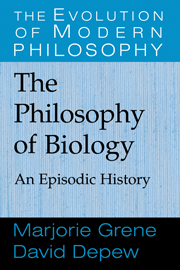Book contents
- Frontmatter
- Contents
- List of Figures
- Notes on Citations and References
- Acknowledgments
- Preface
- 1 Aristotle and After
- 2 Descartes, Harvey, and the Emergence of Modern Mechanism
- 3 The Eighteenth Century I
- 4 The Eighteenth Century II
- 5 Before Darwin I
- 6 Before Darwin II
- 7 Darwin
- 8 Evolution and Heredity from Darwin to the Rise of Genetics
- 9 The Modern Evolutionary Synthesis and Its Discontents
- 10 Some Themes in Recent Philosophy of Biology
- 11 Biology and Human Nature
- 12 The Philosophy of Biology and the Philosophy of Science
- References
- Index
9 - The Modern Evolutionary Synthesis and Its Discontents
Published online by Cambridge University Press: 05 June 2012
- Frontmatter
- Contents
- List of Figures
- Notes on Citations and References
- Acknowledgments
- Preface
- 1 Aristotle and After
- 2 Descartes, Harvey, and the Emergence of Modern Mechanism
- 3 The Eighteenth Century I
- 4 The Eighteenth Century II
- 5 Before Darwin I
- 6 Before Darwin II
- 7 Darwin
- 8 Evolution and Heredity from Darwin to the Rise of Genetics
- 9 The Modern Evolutionary Synthesis and Its Discontents
- 10 Some Themes in Recent Philosophy of Biology
- 11 Biology and Human Nature
- 12 The Philosophy of Biology and the Philosophy of Science
- References
- Index
Summary
What Is the Modern Evolutionary Synthesis?
The Modern Evolutionary Synthesis has served as the dominant interpretive framework that has guided professional evolutionary biology during the central decades of the twentieth century. Just what was being synthesized? In the 1920s and 1930s, there occurred a synthesis between Mendelian genetics and Darwinism, whose champions had earlier been at each others' throats (see Chapter 8). The central figures in this effort were R. A. Fisher, J. B. S. Haldane, and Sewall Wright. However, the phrase “modern evolutionary synthesis” refers not only to the synthesis between Mendelism and Darwinism, but to a sustained effort extending from the late 1930s through the 1940s to use “population genetics,” in the sense worked out by these pioneers, to unify – synthesize – a wide array of biological disciplines. That is how Julian Huxley, grandson of Thomas Huxley, used the phrase in his 1942 book Evolution: The Modern Synthesis, which gave the Synthesis its name. Huxley listed “ecology, genetics, paleontology, geographical distribution [biogeography], embryology, systematics, [and] comparative anatomy” as “converging upon a Darwinian center,” thereby rescuing Darwinism from its turn-of-the century “eclipse” (Huxley's phrase) and, in Huxley's opinion, bringing into being for the first time a truly modern, theoretically based, biology (Huxley 1942; 1943, p. 25). Key figures in the Modern Synthesis in Huxley's sense were Theodosius Dobzhansky, Ernst Mayr, George Gaylord Simpson, and G. Ledyard Stebbins. All these figures wrote books in a series published by Columbia University Press between 1937 and 1952.
- Type
- Chapter
- Information
- The Philosophy of BiologyAn Episodic History, pp. 247 - 289Publisher: Cambridge University PressPrint publication year: 2004

